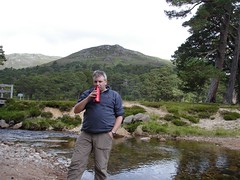Just finished "Learning to see Creatively" by Bryan Peterson, out of the Gallowgate library. The book is subtitled "How to compose great photographs". Although almost 20 years old now, the book is timeless. Something that some people seem to forget, is that whatever technology you are using, the story that you are telling is important.
If you are writing, you want to do your best to put your message across. If you are using graphics, you want to work to the best of your abilities to communicate your message. With audio, you want to use your sounds, voice, instruments to communicate the desired message. Why accept mediocrity - if you don't care about your work, do you think anyone else will?
As you look through the book, Peterson discusses how he improved his work (e.g. p84/5), shows different techniques and lets you choose (e.g. p94/5). Admits that some techniques are for "who cares" moments (p120), and that without proper planning, you can end up in a valley that doesn't catch the sunset that you went there to photograph (p126).
One lesson directly learnt for me was Sunday morning's photographs of the "Painted Lady" - once I saw what the sunlight was like, I grabbed my camera. The effects might not have been spectacular, but at least it shows that I'm alive, and trying to improve on my skills.
Contents:
- Expanding your vision with lenses - wide-angle, normal, telephoto, macro & closeup lenses.
- Elements of design - line, shape, form, texture, pattern.
- Composing strong photographs - filling the frame, defining the horizon, vertical vs horizontal, skewing the PoV, framing the image, silhouetting the subject, breaking the rules.
- Understanding your exposure options - shutter speed, aperture.
- The magic of available light - shooting from dawn to dusk, the advantage of overcast.





No comments:
Post a Comment